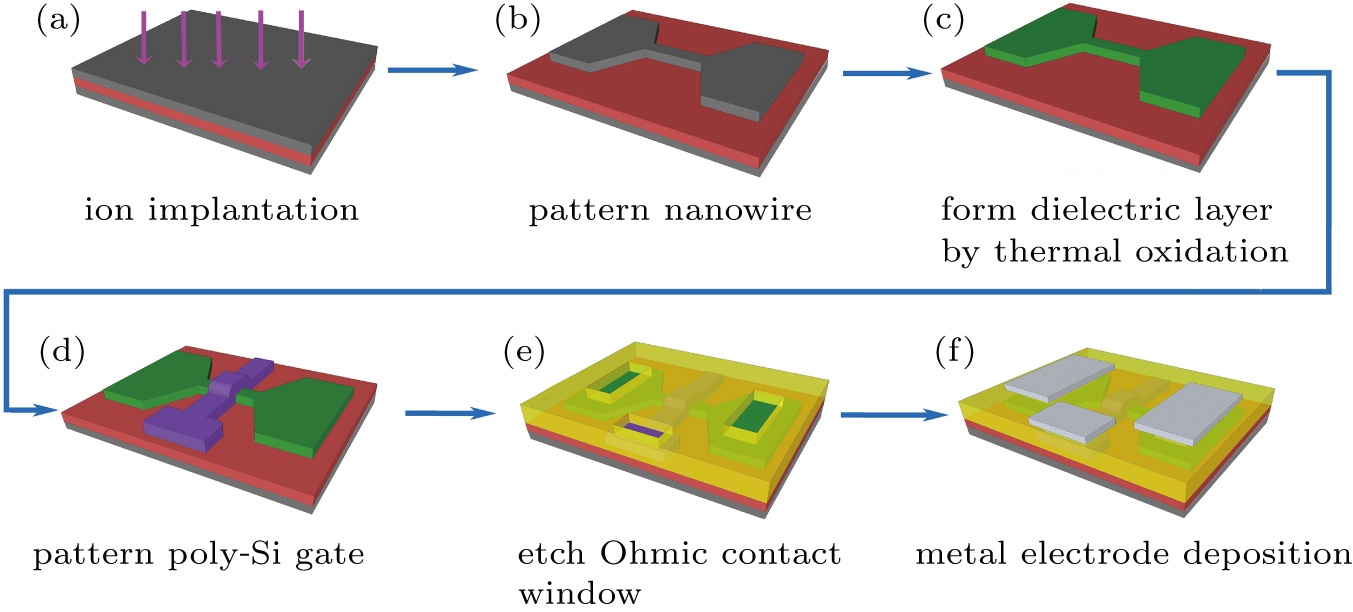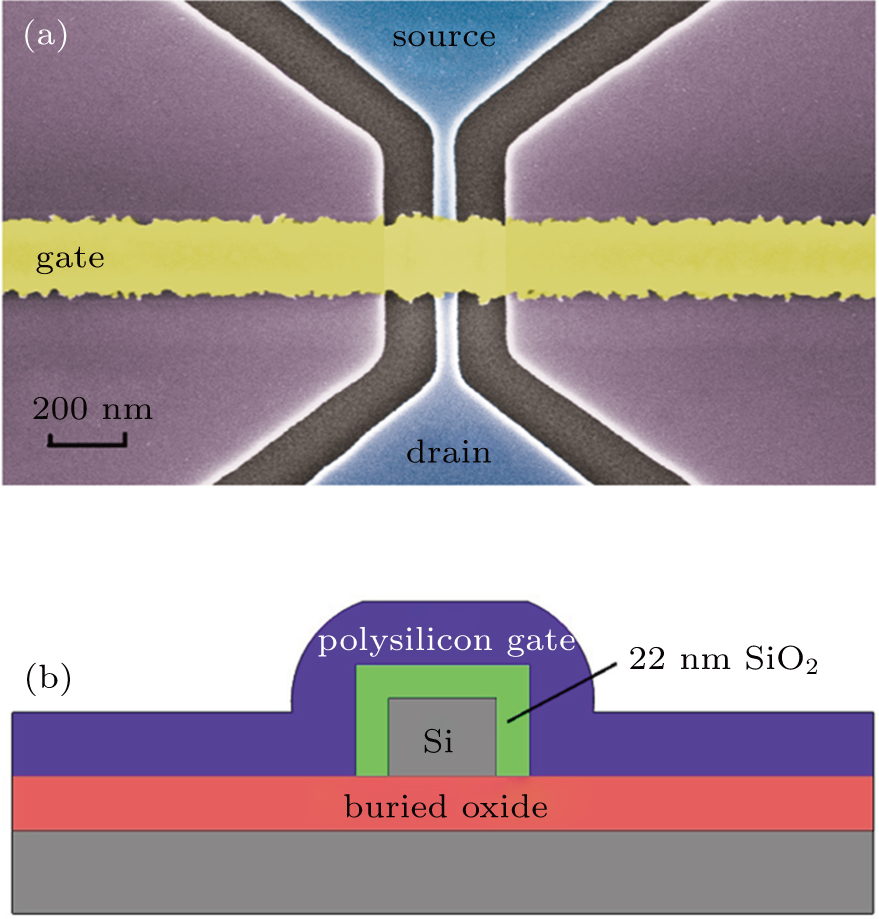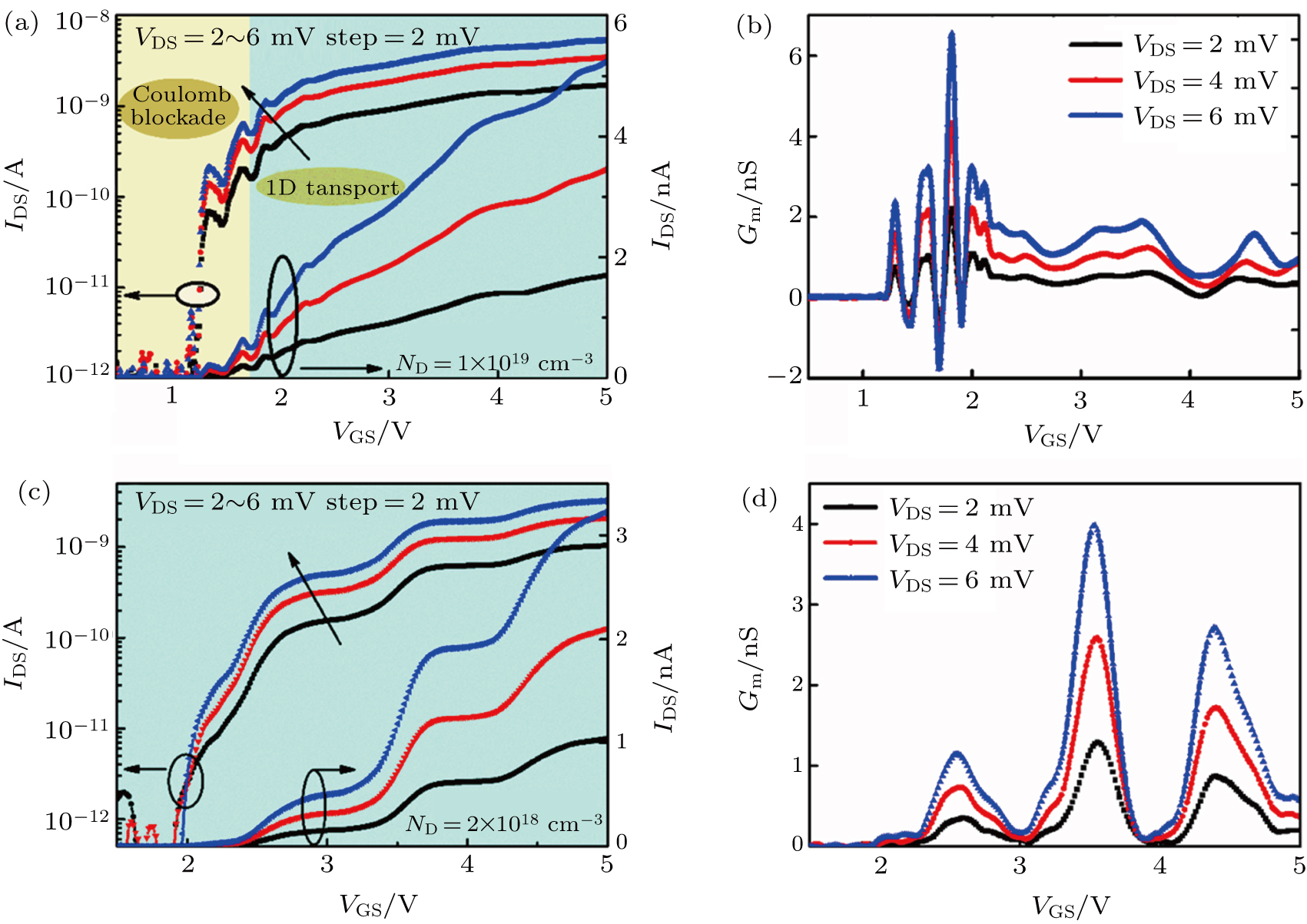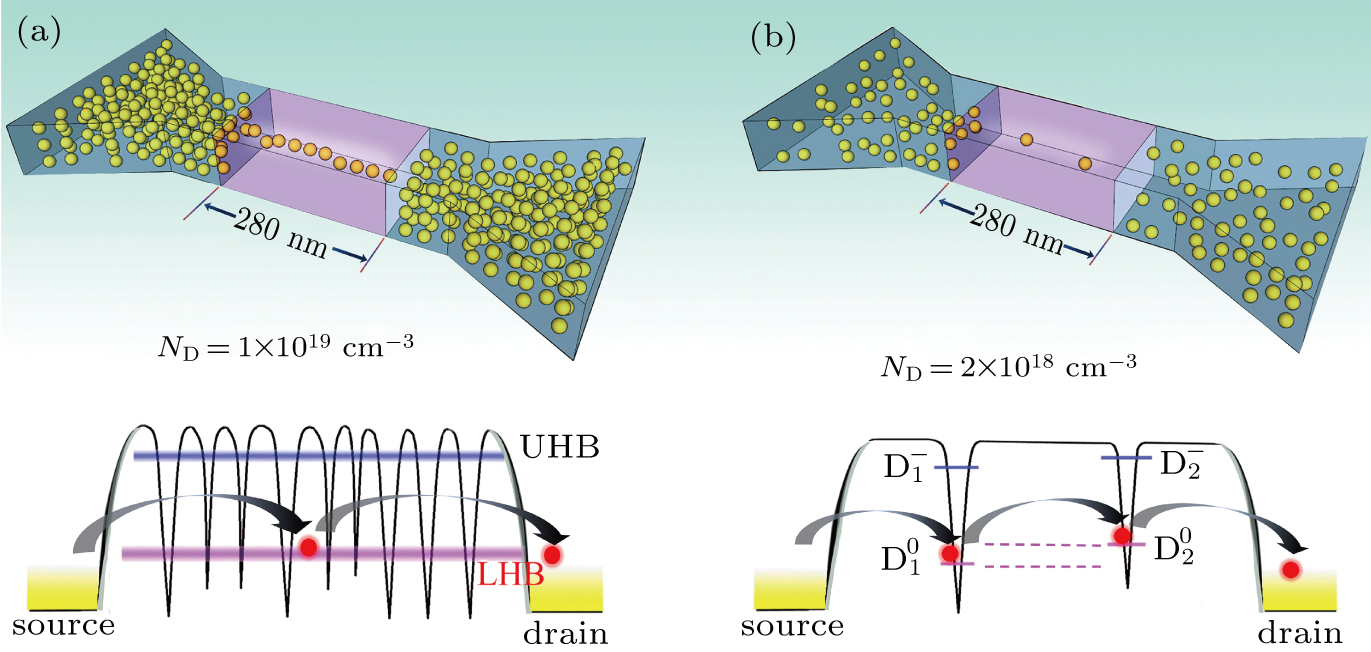† Corresponding author. E-mail:
Project supported by the National Key Research and Development Program of China (Grant No. 2016YFA0200503), the Program for Innovative Research Team (in Science and Technology) in University of Henan Province, China (Grant No. 18IRTSTHN016), and the National Natural Science Foundation of China (Grant Nos. 61376096, 61327813, and 61404126).
We discuss the random dopant effects in long channel junctionless transistor associated with quantum confinement effects. The electrical measurement reveals the threshold voltage variability induced by the random dopant fluctuation. Quantum transport features in Hubbard systems are observed in heavily phosphorus-doped channel. We investigate the single electron transfer via donor-induced quantum dots in junctionless nanowire transistors with heavily phosphorus-doped channel, due to the formation of impurity Hubbard bands. While in the lightly doped devices, one-dimensional quantum transport is only observed at low temperature. In this sense, phonon-assisted resonant-tunneling is suppressed due to misaligned levels formed in a few isolated quantum dots at cryogenic temperature. We observe the Anderson-Mott transition from isolate electron state to impurity bands as the doping concentration is increased.
In recent years, due to the advanced micro/nano-fabrication technologies,[1,2] the typical channel length of metal–oxide–semiconductor field-effect transistors (MOSFETs) has dropped to 10 nm. The rapid downscaling of MOSFETs has made the number of impurities sharply reduced in the channel. In nanoscale channel, the random distribution of dopants greatly influences the conductivity of devices.[3–5] In the case of nanowire device, a single impurity can easily affect the entire carrier flow. The effects of single dopants in the channel of a silicon device have been characterized in recent years.[6] The carrier behavior will be dominated by quantum mechanism and tunneling at low temperatures. Single electron transport mediated by individual dopants in silicon transistors has been observed, in particular at low temperatures below 20 K.[7–9] Previous publications which describe the influence of local donor induced quantum dots (QDs) on electrical characteristics mostly focus on inversion-mode transistors. The junctionless nanowire transistor (JNT), considered as a gated resistance with uniform doping, has been recently proposed as a promising alternative for a new generation of transistors.[10] Compared to the inversion-mode transistors, carrier in the JNTs flows in the middle of the channel rather than in the thin surface inversion layer. Hence, JNT leads to a more apparent quantum-confinement effect on the carrier transport and can provide a unique opportunity to probe the dopant fluctuation effects on the carrier transport in low dimensions.[11,12] At the initial stage of subthreshold, the lowest potential is formed in the electrical center. The potential landscape of the conduction path is modified by the dopant number. Consequently, the doping concentrations will significantly influence the carrier transport characteristics.
To ensure high current drive as well as full depletion of all the channel region, the suitable doping density of the fabricated junctionless transistor is 2 × 1018 cm−3 ∼ 1 × 1019 cm−3.[10] In this paper, heavily-doped and lighter-doped JNTs with the channel length of 280 nm are fabricated. We investigate the influence of dopant concentration on the quantum transport patterns in long-channel JNTs. The features of quantum transport in Hubbard systems are only observed in heavily-doped device with a doping concentration of 1 × 1019 cm−3. While in the lighter-doped channel with a doping concentration of 2 × 1018 cm−3, no single electron transport is observed, and only one-dimensional quantum transport is observed. This work provides a basic qualitative description of electronic transport properties of random dopant fluctuation in nano-scale transistors.
Figure
Figure
The fabricated JNTs were placed in a vacuum chamber which can be cooled down to 6 K with the help of Lakershore-340 temperature controller. As a whole, 100 samples have been studied electrically, mostly at a low temperature to observe the quantum effect in the narrow channel region. The doping concentrations of both types of devices show random dopant-induced threshold voltage fluctuations. Figure
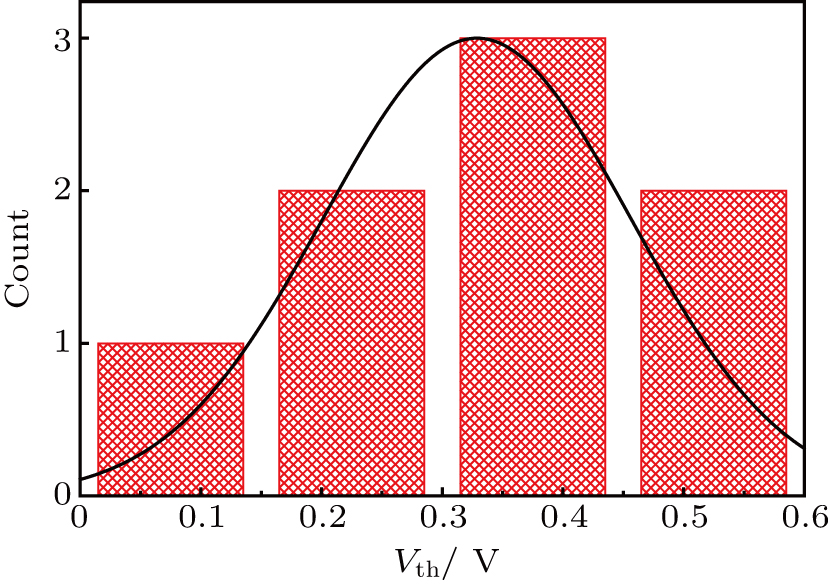 | Fig. 3. (color online) Distribution of threshold voltages calculated for devices with a doping concentration of 1 × 1019 cm−3. All measured devices have a cross section of 35 nm × 30 nm. |
Figure
Through the above analysis, we can make sure that the electron transport mechanism through QDs is totally different at the initial stage of subthreshold. To obtain the root cause of the difference in transport mechanism, fundamental studies about the behavior of individual ionized donor in the channel should be performed. We obtained the density of ionized impurity atoms 



 | Fig. 5. (color online) Ionization ratio as a function of temperature for several doping concentrations. |
At high doping concentrations of ND = 1 × 1019 cm−3 (above the metal-insulator transition concentration), most donors are ionized even at low temperature. If we assume the size of the initial conduction path is comparative to the Bohr radius of 2 nm for phosphorus atom in silicon, the average number of ionized donors in the conductive path of type-A JNT is approximately 9 (2 nm × 2 × 280 nm × 1 × 1019 cm−3 × 78%). Considering the statistical variation, the ionized donor number may vary from 6 to 12.[13] The coupled QDs array can be formed by a number of phosphorus donors positioned closely to each other, due to the strong interaction between neighboring ionized donors. Therefore, in the system of multiple coupled ionized donors, the neutral state D0 and the negatively charged state D− state develop into two impurity bands, i.e., the lower Hubbard band (LHB) and upper Hubbard band (UHB).[17] For this type of device, as schematically illustrated in Fig.
We now turn to the behaviors of QDs formed in the JNT channel with the doping density of 2 × 1018 cm3. In case B, the average number of ionized donors in the conductive path below the gate is one. Consequently, none or only a small number of QDs are formed in the center of the channel below the threshold. When elastic tunnel process is the dominant transport mechanism, electron through a few QDs is resonantly enhanced only when the levels of QDs are aligned. Actually, localized quantum states of QD are different from each other with regard to the random distribution of donors. Resonant tunneling through double QDs is illustrated in Fig.
In this work, we report the electrical measurement results of two types of n-doped JNTs with different doping concentrations at low temperature. The influence of doping concentration on the electrical characteristics of JNTs is investigated. Donor-induced fluctuation is observed even in heavily doped device, resulting in threshold voltage fluctuation. The electron transport behavior is significantly different depending on whether phosphorus donors in the channel region are strongly coupled with each other. Strongly-coupled dopants control the Hubbard bands conductance in nanoscale transistors with heavily doping concentration of 1 × 1019 cm−3. While in JNT channel with a lighter doping concentration of 2 × 1018 cm−3, conduction path belongs to the isolated donor regime and forms misaligned localized quantum states. The transport mechanisms extracted from the electrical measurements provide important information on quantum states of donors in subthreshold regime.
| [1] | |
| [2] | |
| [3] | |
| [4] | |
| [5] | |
| [6] | |
| [7] | |
| [8] | |
| [9] | |
| [10] | |
| [11] | |
| [12] | |
| [13] | |
| [14] | |
| [15] | |
| [16] | |
| [17] | |
| [18] | |
| [19] |


